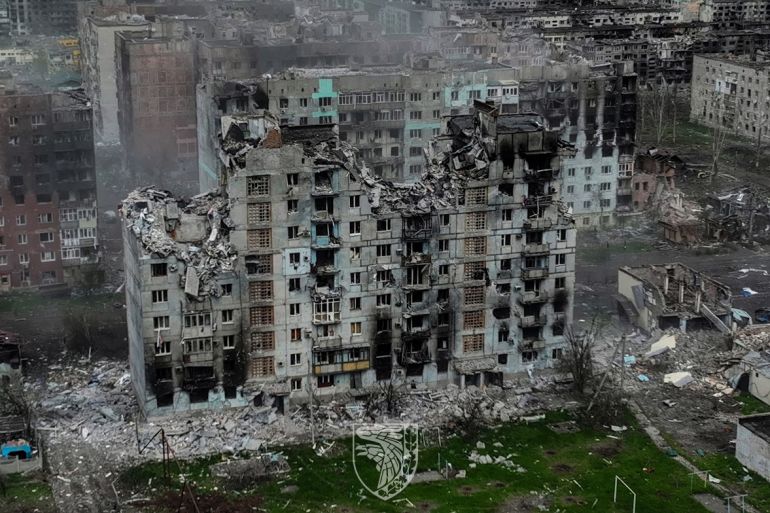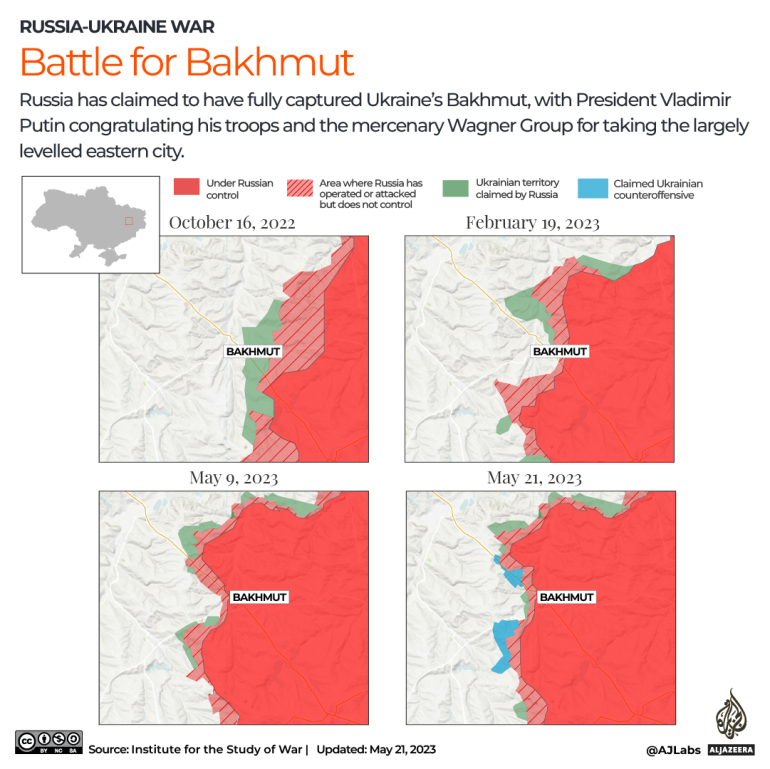Ukraine and Russia trade places in battle for Bakhmut
What happened in the 65th week of Russia’s war in Ukraine?

Russia’s Wagner Group claims to have captured Bakhmut in eastern Ukraine this week, but the government in Kyiv says it intends to recapture the ruined city after surrounding it.
“We continue to advance on the flanks in the suburbs of Bakhmut and are actually approaching the capture of the city in a tactical encirclement,” overall ground forces commander Oleksandr Syrskyi said as Ukrainian forces added that they had recaptured 4sq km (1.5sq miles) of territory
Keep reading
list of 3 itemsRussia-Ukraine war: List of key events, day 454
Ukraine courts ‘Global South’ in push to challenge Russia
The battle for Bakhmut has increasingly been the focal point of the war, now in its 65th week, as Russian President Vladimir Putin prioritised capturing the region of Donetsk, in which the city with a pre-war population of 70,000 is situated, and neighbouring Luhansk.
Ukraine says it has used attritional street warfare in Bakhmut to draw in Russian forces from other parts of the front and to inflict high casualties. Over the past two weeks, its forces also launched a number of flanking operations around the city to reclaim land.
“Ukrainian counterattacks near Bakhmut have notably likely eliminated the threat of a Russian encirclement of Ukrainian forces in Bakhmut and forced Russian troops to allocate scarce military resources to defend against a limited and localized offensive effort, as Ukrainian command likely intended,” the Washington-based Institute of the Study of War said on Friday.

The following day, Yevgeny Prigozhin, head of the Wagner Group and its mercenary forces, said they had captured Bakhmut. Russia’s Ministry of Defence followed with an overnight announcement that it had conquered the city – competing, as they have done for months, for credit on the eastern front.
The online news service Meduza also said Bakhmut, for all intents and purposes, had been captured. The “disputed” area consists only of “a dozen high-rise buildings, schools, a kindergarten and some garages at the end of Tchaikovsky Street”, it said.
But Ukrainian Deputy Defence Minister Hanna Maliar said the defenders still held an area of “industrial and infrastructure facilities” in the southwestern outskirts of the city, known as the “airplane neighbourhood” because of a monument of a MiG-17 fighter plane there.
Maliar said Ukrainian troops remained in the neighbourhood on Tuesday. A day earlier, eastern forces spokesman Serhii Cherevaty said Ukrainian soldiers carried out flanking manoeuvres to the city’s north and south and had pushed forward 200 to 400 metres (220 to 440 yards), indicating that the battle was anything but over.
Russia has committed enormous resources to the battle.
On Saturday, Maliar said Moscow had sent several thousand reinforcements to Bakhmut. Cherevaty said they included airborne, motorised rifle and special forces. British military intelligence said it believed they could be several battalions, underlining the importance of the battle to the Kremlin.
“Russia’s leadership likely continue to see capturing Bakhmut as the key immediate war aim, which would allow them to claim some degree of success in the conflict,” a British intelligence analysis said.
Andriy Yusov, Ukraine’s military intelligence spokesman, said on Sunday, “The fact that the enemy is forced to transfer additional reserves in order to continue the operation on Bakhmut, in general, indicates the failure of their offensive actions.”
The Wagner Group has done the brunt of the fighting in Bakhmut, and Prigozhin threatened to pull out earlier in May, an action the Ministry of Defence said would be dealt with as treason. But on Sunday, Prigozhin said his soldiers would evacuate the theatre beginning on Thursday.
Incursion into Belgorod
Farther to the northeast, meanwhile, two pro-Ukrainian and anti-Kremlin militias on Monday staged a rare incursion into Russian territory.
Vyacheslav Gladkov, the governor of Russia’s Belgorod region bordering Ukraine, said the Federal Security Service, Border Service and National Guard were battling “a sabotage and reconnaissance group of the Armed Forces of Ukraine”.
The Ukrainian government denied any involvement, but members of the two groups – identified as the Russian Volunteer Corps and the Freedom of Russia Legion – claimed responsibility.
“Residents of Russia! We are Russians just like you,” said a video posted by the Freedom of Russia Legion. “The only difference between us is that we no longer wanted to justify the actions of criminals under the power of Russia and took up arms to defend our freedom and yours. Putin’s Russia has rotted from corruption, censorship and repression.”
Military reporters said the groups had captured the settlement of Kozinka near the border and attacked two others.
Yusov identified the fighters as Russian partisans who had launched “an armed struggle against the criminal regime of Vladimir Putin.” He said they could create a “certain security zone in the border regions of Russia bordering Ukraine”, from which shelling has been directed at Ukrainian towns and settlements.
It was not clear what role Ukraine had played, if any, in arming the groups. Russia’s Ministry of Defence also said nothing about the provenance of their weapons. Ukrainian presidential adviser Mykhailo Podolyak said Ukraine “observes the events in the Belgorod region of Russia with interest … but has no direct relation to it”.
On Tuesday, Russia’s defence ministry said it had driven the forces back into Ukraine and said it had killed more than 70 of their fighters. Air raids, artillery fire and units covering the state border of the Western Military District were involved, the ministry said.
F-16s green-lighted
Separately, Western arms supplies to Ukraine reached another inflection point this week as United States President Joe Biden backed the joint allied training of Ukrainian pilots on F-16 fighter jets, before a decision is taken on how to do the provision of the aircraft – a pressing request by Ukraine.
Speaking on the sidelines of a G7 meeting in Hiroshima, Japan, Zelenskyy assured Biden that the planes would not be used to strike Russian territory.
US national security adviser Jake Sullivan said the F-16s were not part of an anticipated Ukrainian counteroffensive that is expected to begin soon.
“We’ve reached a moment where it is time to look down the road and say, ‘What is Ukraine going to need as part of a future force to be able to deter and defend against Russian aggression as we go forward?’ F-16 fourth-generation fighter aircraft are part of that mix,” Sullivan said at a White House briefing.
The G7 signed off on new sanctions against Russia targeting its energy, metallurgical, technology and defence industries. They also targeted “an international network of organizations that procure components for the Russian company that produces Orlan drones”.
Ukrainian intelligence pointed out months ago that Russia was procuring sensitive parts such as microchips from Western companies for its missile and drone industry by shipping them through intermediary countries.